When it comes to mushrooms, shelf mushrooms are a unique and popular variety. Belonging to the family of polypores, shelf mushrooms, also called bracket fungi, offer many benefits to those who use them.
Common edible shelf fungi include chicken of the woods, hen of the woods, and ox tongue. Inedible fungi, like artist’s conk, can be used in making teas and dyes.
These fungi can be found growing in a variety of places from dead logs to living trees. Below we’ll look at different types of bracket fungi with images to help you with identification.
Types of Bracket Fungi
1. Chicken of the Woods
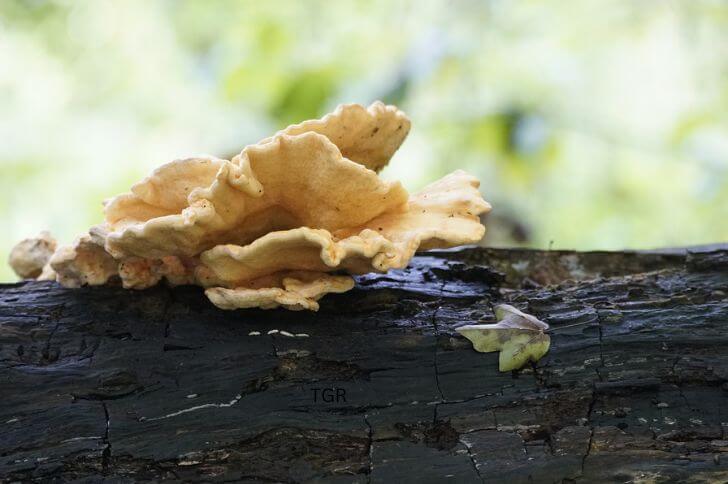
Chicken of the woods is a favorite for foragers, as it has a unique chicken-like flavor and texture when cooked. To ensure that you have the right species, it’s important to know exactly how to identify this bracket fungus.
Identification:
First, they are easily identified by their bright orange and yellow coloration in either fan-like or shelf-like formations. The undersides will have white pores instead of gills which can also help distinguish it from other species. Additionally, its texture may feel slightly leathery or spongy to the touch.
Where can I find this orange shelf fungus? Chicken of the woods favors dying oaks, beech, and sweet chestnut. You may also find them on willows.
We recommend you harvest young species that are tender and tastier. Cook before consumption. This orange shelf fungus can be grown at home.
2. Hen of the Woods
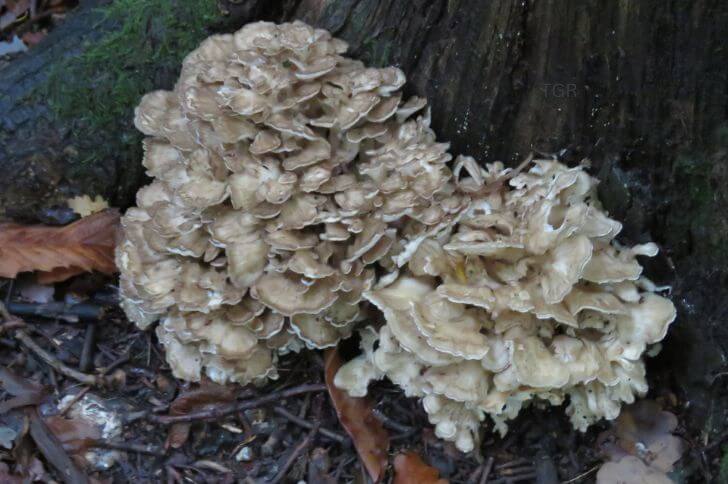
Because of its name, this shelf mushroom may sound like it’s related to the bracket fungi above but they are not related. Hen of the woods is from the family Meripilaceae while chicken of the woods is from fomitopsidaceae.
Identification:
Hen of the woods mushrooms, scientifically known as Grifola frondosa, is a popular edible mushroom that can be found growing in wooded areas during late summer and early fall. It is also known as ram’s head or maitake.
It is a polypore fungus with a distinguishable fan-like shape that resembles an overgrown chicken’s comb. Additionally, it has thick and wavy fleshy grayish-brown caps that are attached to white stalks.
Another distinguishing feature of these shelf mushrooms are their unique smell; they have a strong woodsy scent which helps them stand out from other fungi species.
Furthermore, it should be noted that these mushrooms thrive on red or white oak trees and can be easily identified by their large size and multiple overlapping caps which merge into one big cluster.
3. White Cheese Polypore
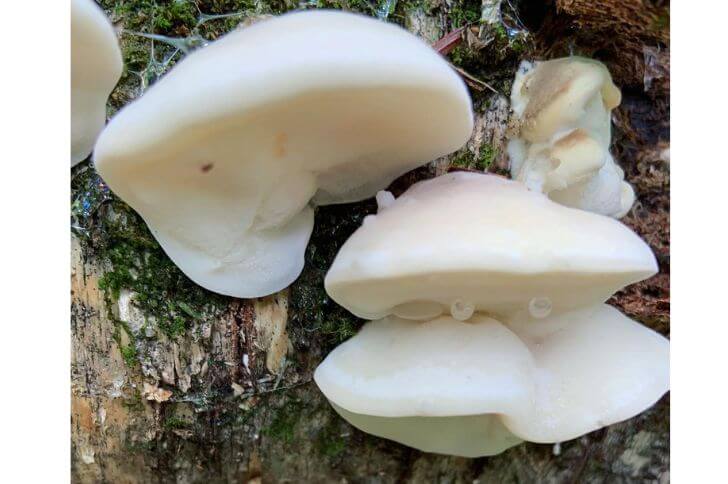
White cheese polypores are white shelf mushrooms that are common in North America. You can find this white polypore mushroom on the sides of dead hardwood trees, mostly birch.
Identification:
The mushroom is also known for its strong pleasant aroma and mozzarella-like texture. The scientific name for this fungus is Tyromyces chioneus.
The fruiting body is fan-shaped and about 4 inches wide. Flesh and surface are white but change grayish as it ages.
White cheese polypore typically grows during the summer months but they can also be found year round in wetter climates where temperatures. They are inedible.
4. Turkey Tails
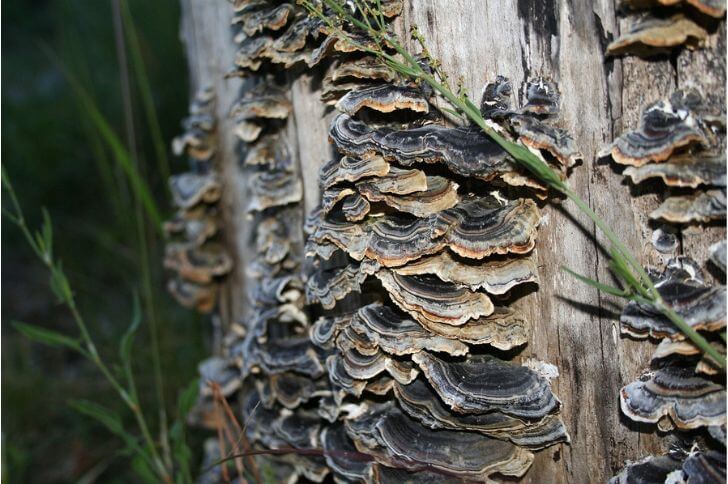
Turkey tails mushrooms are a type of bracket fungus that grows on stumps and logs of deciduous trees but can also be seen growing on wounds of live trees.
Identification:
These mushrooms feature thin fan-shaped caps with concentric zones. Color ranges from brown to yellow to orange to cream. Note the wavy edges.
The underside of the cap has tiny pores instead of gills. Like other bracket mushrooms we recommend you pick young species.
The mushroom should have white edges when young. Is the turkey tail edible? No, its multi-colored flesh is very tough. However, once dried the flesh can be blended and the powder used in soups, tea, smoothies and more.
5. Dryad’s Saddle
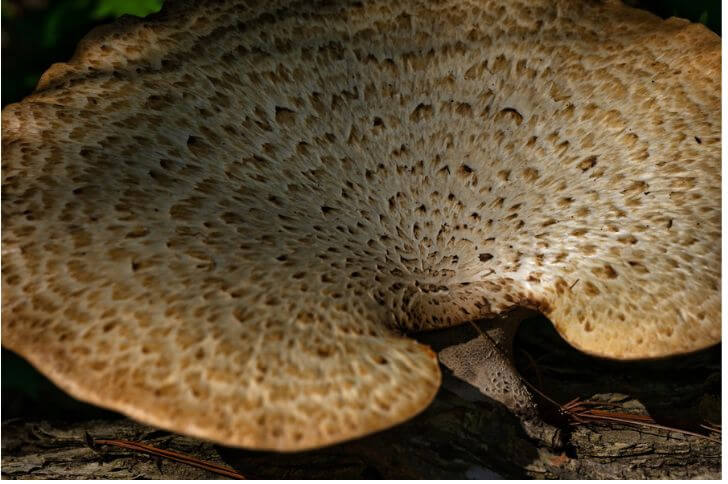
Another common shelf fungus that a forager should know about is the dryad’s saddle. It’s also known as the pheasant’s back mushroom.
Identification:
With its large, fan-shaped cap ranging from four to twelve inches in diameter, this mushroom is easy to spot in wooded areas.
Also the fruiting body is yellowish-brown with darker scales on the surface. Its creamy spore print distinguishes it from other mushrooms that grow in similar conditions.
Lastly, dryad’s saddle grows in clusters on dead maple and elms but can occasionally grow on living trees.
This shelf mushroom is edible when young however finding a young species is a difficult task. If you come across larger and older mushrooms, just enjoy the color and texture and move to better fungi.
6. Northern Tooth Fungi
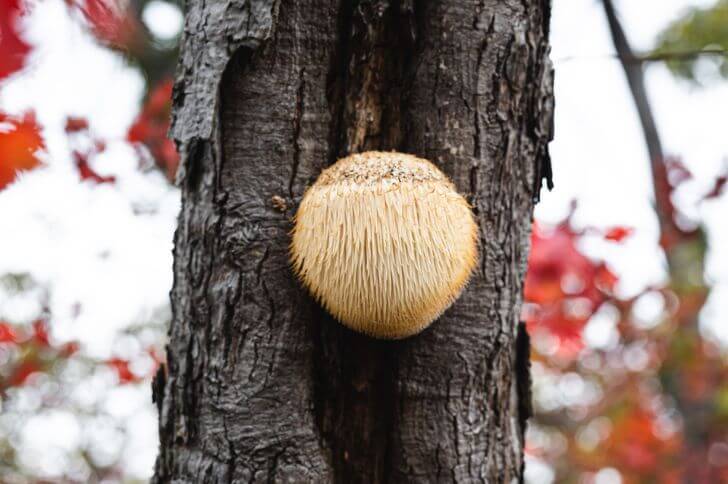
One of the most common mushrooms of Kentucky is the northern tooth fungus. It is also common in northeastern states.
Identification:
Northern tooth fungi identification is a crucial skill for anyone living in the region. The most distinguishing characteristic is the large kidney-shaped fruiting body that can grow up to 15 inches across.
The body is whitish, turning yellow with age. Its surface can be hairy while the underside is covered with 0.5 inch spines.
These white shelf mushrooms grow in large groups. Is the northern tooth fungus edible? Yes, it is classified as edible. But, due to the bitter taste and tough flesh, most experienced foragers do not recommend them.
7. Hemlock Varnish Shelf Mushroom
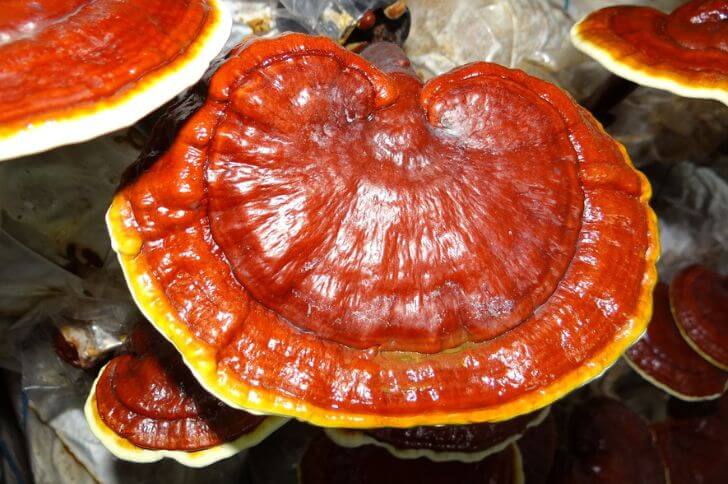
Hemlock varnish shelf mushroom identification is an important skill to have when foraging for mushrooms in the wilderness. Scientifically called Ganoderma tsugae, they are a unique species with a distinct look that makes it easier to identify them.
Identification:
They possess a reddish-brown fan-shaped cap. Young species have white or yellowish edges. They have whitish flesh and no stalks.
Additionally, they feature small pore surfaces underneath the cap which release spores when touched or disturbed. Where can you find hemlock varnish shelf mushrooms? They are common in the pacific northwest and grow mostly on eastern hemlocks.
8. Artist’s Conk Bracket Fungus
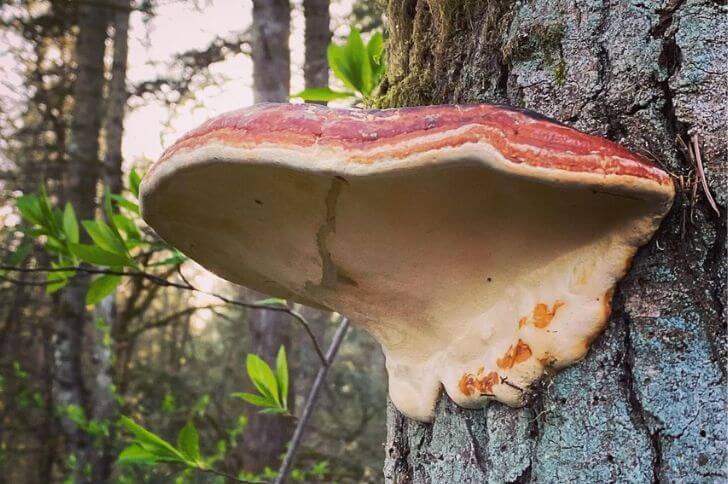
Artist’s conk is one of the most popular shelf mushrooms. These bracket fungi are inedible when fresh but when dried are often ground and used in different soups, smoothies or to make tea.
Identification:
There are three distinguishing features that can help you tell it apart from other shelf fungi. One, artist’s conks have brownish-gray caps with ‘lumpy’ surfaces.
Note its margin is whitish. Two, this shelf mushroom can grow up to 15 inches wide and 3 inches thick. Three, its flesh is cinnamon brown but very tough.
As a bonus feature, this bracket fungus grows in groups or singly on decaying beech. It has a reddish brown spore print.
9. Ox Tongue (beefsteak mushrooms)
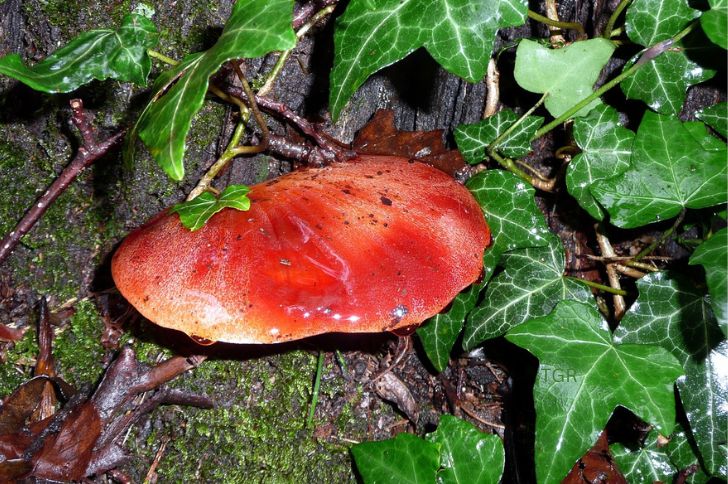
Ox tongue mushrooms are interesting bracket fungi. They are also known as poor man’s steak, maybe because you don’t have to spend a dime on them or because they are not a top tier mushroom. But whatever the case, this bracket fungus has made it to our list.
Identification:
This species of mushroom is sometimes referred to as beefsteak polypore and typically consists of a thick, fleshy cap with no stem. The caps are often reddish-brown in color and have no distinctive aroma. Why is it called beefsteak fungus? Well, it resembles the real thing.
When cut, the flesh of this bracket fungi is red with whitish veins and blood like liquid. Honestly, an untrained eye would be fooled to think this is real raw meat. If you like acidic and slightly bitter food, try adding this mushroom to your salads.
10. Reishi
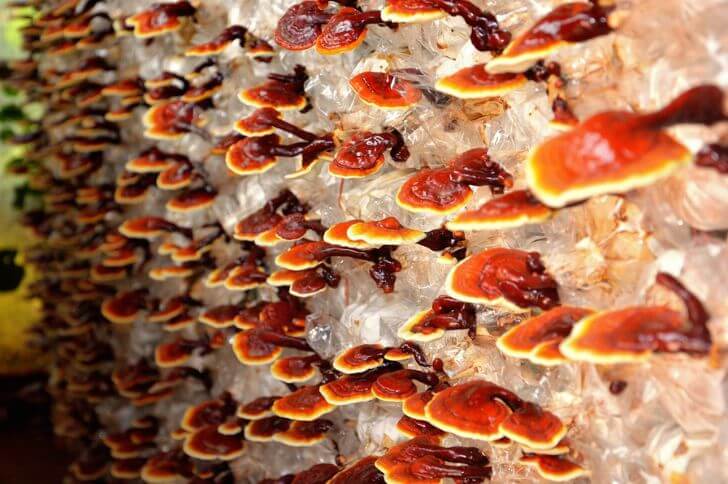
Reishi mushroom identification is an important part of foraging for mushrooms. These highly prized shelf mushrooms are easily identifiable.
Identification:
They have a distinctive fan shape with a glossy reddish cap, brown spores on the underside of the mushroom. Reishi mushrooms tend to grow in clusters on dead hardwood trees such as hemlocks and maple, or near stumps in damp areas with plenty of shade.
They are also quite slow-growing so they won’t look like other larger more aggressive types of fungi. You can find them spring through fall. If you want to harvest this bracket fungus, younger species are better.
Related Read: Check these greenish mushrooms
11. Birch Polypore
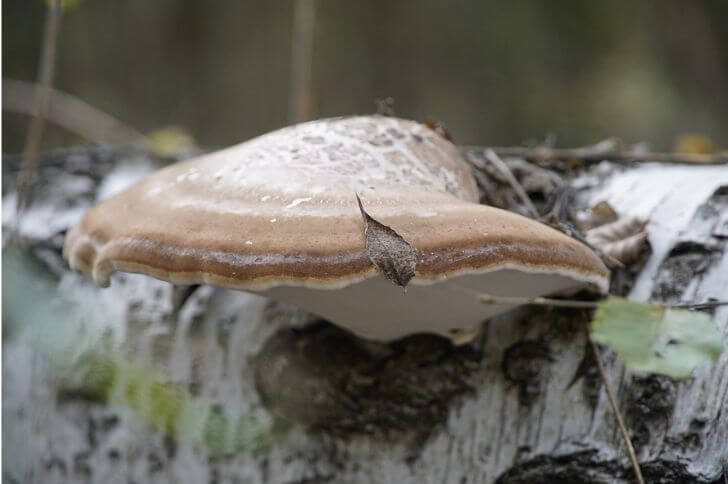
Common all year round, birch polypores are a bracket fungus with many names. They are also called razor strop. The name comes from barbers who used its rough surface to sharpen razors.
Identification:
Recognising these shelf mushrooms isn’t difficult if you know what to look out for. The birch polypore typically has a white-brown cap that is almost flat. Its margins are rolled inwards.
Flip it and you’ll notice the underside is whitish and smoother compared to other bracket fungi. It grows up to 10 inches wide with white flesh that doesn’t change color when cut. Birch polypores are inedible.
12. Red-belted Conk
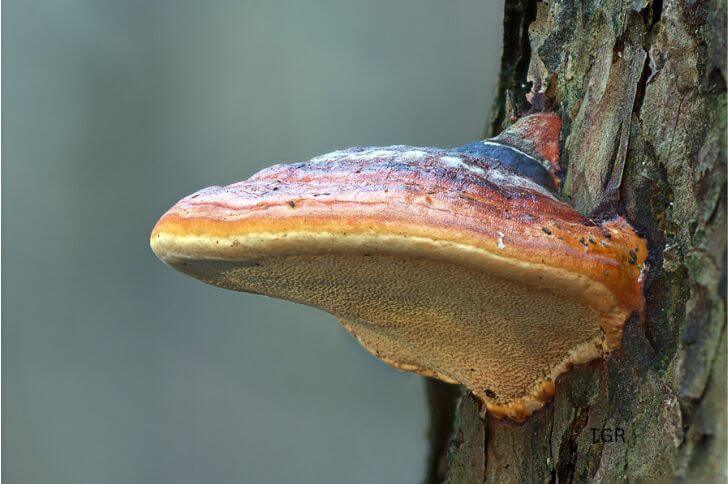
Common in Europe, red-belted conks are often found on conifers as well as beech trees.
Identification:
The caps range from fan-shaped to hoof shaped and grow to 15 inches wide and 7.5 inches thick. Younger red-belted conks are yellowish orange with a thin whitish margin.
As the shelf fungus ages, new layers grow, making the fungus thicker and duller. Red-belted conks are inedible but can be used as tinder.
It’s important to note however that just because a mushroom has the same basic coloration does not necessarily mean it is a red-belted conk – there are lookalikes out there!
13. Cinnabar Polypore
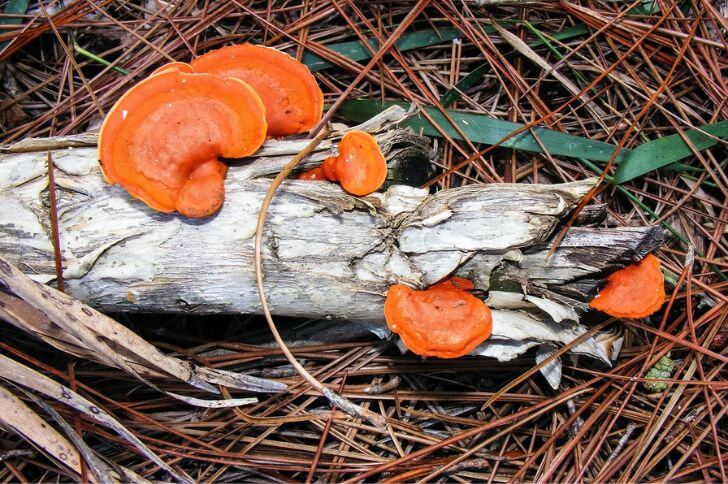
I think the cinnabar polypore is the most striking shelf fungus on this list. It is also very rare.
Identification:
This orange mushroom is a decomposer, growing on trunks of fallen trees. It is easily identifiable by its bright red or orange coloration. As it ages it turns dull orange.
The semi-circular fruiting body grows to about 7.5 inches across. The underside of the cap contains small pores which release spores into the air when the mushrooms are mature.
14. Rosy Conk
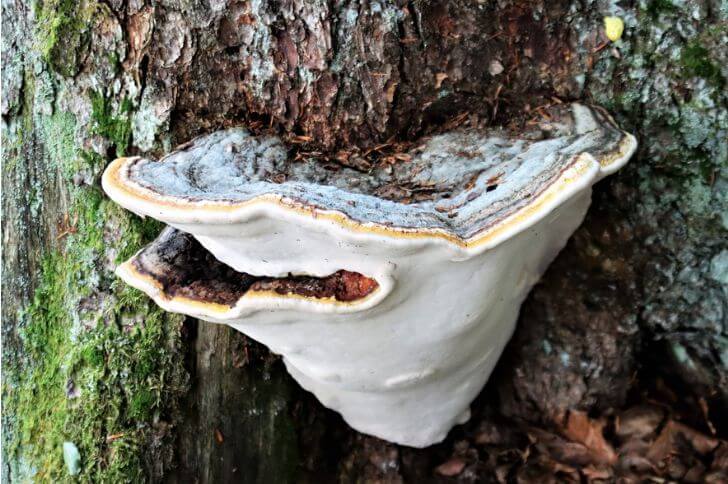
A bracket fungus of western North America, the rosy conk mushroom has a pleasant smell that makes identification easy.
Identification:
This species of mushroom can be identified by its pinkish hue when young. Also, their caps are thin and grow on top of each other. As they age the caps fuse together, forming a thick shelf.
Also, younger rosy conks have a hairy or velvety surface that becomes bald with maturity. Like other bracket fungi, these mushrooms do not have stems. Note the pinkish flesh when sliced.
15. Chaga mushrooms
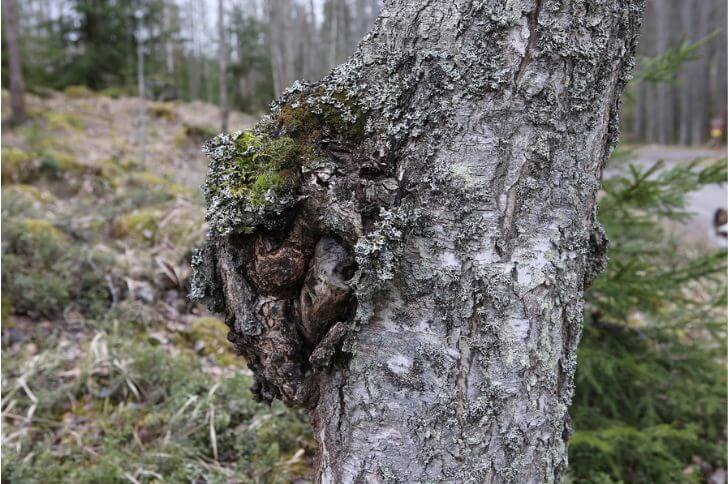
A mushroom of the northern states and the woods of North Carolina, chaga mushrooms are easy to miss because of their color but easily identifiable once you spot them.
Identification:
Chaga mushrooms grow in the form of a large black mass on the trunk or the branches of birch trees. They resemble burnt charcoal and have an outer layer that is cracked and hard to the touch.
Underneath this outer layer, the inner flesh ranges from yellow to dark brown. The shape can vary from spherical structures resembling a lumpy growth to cracked clumps covering patches of bark on tree trunks.
FAQ about Shelf mushrooms
Can you eat shelf mushrooms?
Only the sulphur shelf mushroom is an edible shelf mushroom. Others such as turkey tails, hen of the woods, and turkey tails are dried and used in smoothies and teas.
What are bracket or shelf fungi?
The terms shelf fungi or bracket fungi or polypore are used to describe fan-shaped mushrooms that grow on wounds of live trees or on dead trees. They have hard caps and are mostly inedible.
How long do bracket fungi live?
Some species such as chicken of the woods appear in spring while others like birch polypore are available all year round.
Sources:
Hi There,
My name is Jenny. I’m the Chief Editor at Try Green Recipes and besides making yummy and healthy foods for my kids, grandkids, and friends. I’m new to the blogging world but I believe what I have to share is unique and will bring joy to your home. If you are adventurous and want try something tasty, let’s get started.

